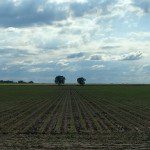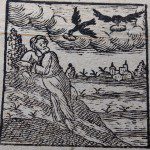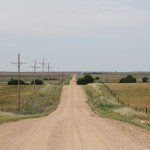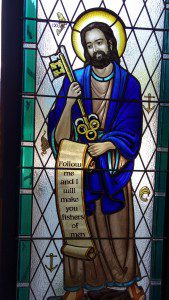
We spent the last week wandering around Boston. We lived in the city when we were first married, and it’s one of our favorite places. Down in South Boston, near a canal and a swathe of red brick warehouse buildings, we stumbled upon a little chapel: Our Lady of Good Voyage. It’s a shrine originally built for sailors and dock workers to stop and pray in the midst of their labors in an age when Boston would have been largely Catholic. The church relocated the shrine to its current high foot-traffic location earlier this year. The sanctuary is shaped to look like an inverted ship, and there’s a carved wooden statue of Mary cradling little Jesus in one arm and a clipper ship in the other.
I was drawn to the stained glass depiction of Peter in the foyer, holding the keys to the kingdom and a scroll bearing Jesus’ words, “Follow me and I will make you fishers of men.” Surrounded by nautical symbols, Peter seems more of an actual fisherman than a fisher of men. It’s no wonder the church has long named Peter the patron saint of fisherman, though Jesus’ words ostensibly called Peter away from his life on the water and into a life following him.
Of course, Peter came full circle and returned to fishing for a stint after the resurrection (John 21). I’d always seen Peter and the other disciples’ decision to hit the Sea of Galilee with their boats and nets as something of an act of desperation: they couldn’t wrap their minds around the resurrection, so they did something concrete and familiar and comforting, wrapping their calloused hands around fishing nets.
Yet, I wonder if I’ve gotten it all wrong. Perhaps Peter and the disciples didn’t fully understand their own motives, but what if they were taking a few first, tentative steps at authentically living out the gospel right where they were, on their home turf–or, as it were, waves? Perhaps theirs was an act, not of despair, but of faithfulness to the core meaning of the gospel. After all, following Jesus isn’t about being called out of life into something special. Christian faith is relational and incarnational and locational. We live it right where we are, or not at all. Maybe, on some deep level where the resurrection had percolated down into Peter’s heart, he knew this, and he responded by going fishing.
Jesus’ gospel call is always both/and, something beyond ourselves and something where we find ourselves. And so the church is always straddling that call, always drawing people as Jesus drew Peter to a life that is deep and wide, but also quite simple and straightforward. It doesn’t require any special tools. It doesn’t happen in any special place. Here it is.
The Our Lady of Good Voyage shrine we stumbled upon is the Catholic Church’s rather attractive take on living out the gospel in place in South Boston. But I’m convinced it’s something all churches are called to in one form or another. It might not be the seaport and sailors, but it will be the city or the country or the burbs. There will be the aliveness of the gospel in the midst of human life, the church in place.
We’re called to be the church in place, to become people of Christ in particular places. Gospel knowledge must ultimately be tethered to local knowledge.
This isn’t just because we have to speak the local idiom in order for our message to be understood. There’s more to it than that. It’s because we’re called to love those we engage with the message of Jesus, and love always requires authenticity. Love calls that authenticity forth. Love leads us to become those who are of and for and with a people.
What I’ve discovered is that this sort of message is all well and good when we’re talking about the way the church lives its call in the world’s big and bustling places. But I’m not clear we’re serious about the church being the church of and for and with rural people–at least judging from some of the books and advice on church growth and church planting I’ve discovered out there.
I don’t even mean the new church aesthetic. Rough wooden pallets behind the stage look pretty cool. And people everywhere in our nation–including out in the sticks–are taking their cues from a kind of suburban metaculture that’s bigger than any one place and looks like Starbucks and McDonalds and vinyl siding. Maybe our churches have to tap into that look in order to tap lives for Jesus. I don’t know, and I’m not necessarily against it.
But I wonder if as the church we’re up to the challenge of authentically living out the gospel in some of the littlest and most out of the way places–places our suburbanizing age has declared dull backwaters, places whose stories have been flattened out by a narrative of decay and decline.
Can we learn to authentically be the church in rural communities, giving up on misplaced longings for hipper suburban models of church where the pastor dons skinny jeans and we all get to swig better coffee? This won’t mean cultivating some sort of superficial rurality where we centerpiece flannel and agriculture.1 We don’t have to found the Our Lady of Demolition Derby shrine.
But can we learn to be with people as they are, living and sharing the gospel among people where they’re at? Just as Jesus called Peter off the boat to become a “fisher of men,” so too Peter eventually came full circle and found himself living out his resurrection faith back out on his familiar waters. Peter lived out the authentic, locational gospel.
Can we?
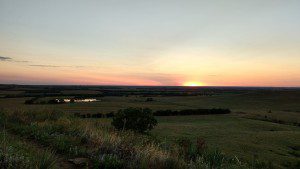
1 Agriculture is of course important in rural places, but rural is not constituted by agriculture. Only around 6% of people in rural communities work in ag, a fact which jives pretty well with the makeup of the rural congregations I know.

